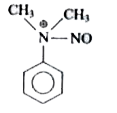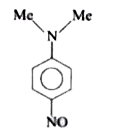Aniline reacts with excess of to form :
The correct Answer is:B
To solve the question of what aniline reacts with excess COCl2 and KOH to form, we can follow these steps:
1. Identify the Reactants:
- The reactants are aniline (C6H5NH2), phosgene (COCl2), and potassium hydroxide (KOH).
2. Understand Aniline's Structure:
- Aniline consists of a benzene ring attached to an amino group (-NH2). The nitrogen atom has a lone pair of electrons that can act as a nucleophile.
3. Nucleophilic Attack:
- Aniline will act as a nucleophile and attack the electrophilic carbonyl carbon of phosgene (COCl2). The carbonyl carbon is positively charged due to the electronegativity of the oxygen atom.
4. Formation of an Intermediate:
- The attack results in the formation of an intermediate where the nitrogen of aniline forms a double bond with the carbonyl carbon, leading to the structure:
- C6H5-NH-C(=O)-Cl.
5. Release of HCl:
- The intermediate undergoes a rearrangement where a chloride ion (Cl-) is released, resulting in the formation of an acyl derivative of aniline.
6. Role of KOH:
- KOH acts as a base and abstracts a proton (H+) from the nitrogen atom of the intermediate, generating a negatively charged nitrogen.
7. Final Product Formation:
- The negatively charged nitrogen can then facilitate the release of another chloride ion, resulting in the formation of phenyl isocyanate (C6H5-N=C=O).
8. Conclusion:
- The final product of the reaction between aniline, excess COCl2, and KOH is phenyl isocyanate.
Final Answer:
The reaction of aniline with excess COCl2 and KOH forms phenyl isocyanate.
---
- The reactants are aniline (C6H5NH2), phosgene (COCl2), and potassium hydroxide (KOH).
- Aniline consists of a benzene ring attached to an amino group (-NH2). The nitrogen atom has a lone pair of electrons that can act as a nucleophile.
- Aniline will act as a nucleophile and attack the electrophilic carbonyl carbon of phosgene (COCl2). The carbonyl carbon is positively charged due to the electronegativity of the oxygen atom.
- The attack results in the formation of an intermediate where the nitrogen of aniline forms a double bond with the carbonyl carbon, leading to the structure:
- C6H5-NH-C(=O)-Cl.
- The intermediate undergoes a rearrangement where a chloride ion (Cl-) is released, resulting in the formation of an acyl derivative of aniline.
- KOH acts as a base and abstracts a proton (H+) from the nitrogen atom of the intermediate, generating a negatively charged nitrogen.
- The negatively charged nitrogen can then facilitate the release of another chloride ion, resulting in the formation of phenyl isocyanate (C6H5-N=C=O).
- The final product of the reaction between aniline, excess COCl2, and KOH is phenyl isocyanate.
The reaction of aniline with excess COCl2 and KOH forms phenyl isocyanate.
Topper's Solved these Questions
- AMINESBook:VMC MODULES ENGLISHChapter:AMINESExercise:ILLUSTRATION
Explore 25 Videos
- AMINESBook:VMC MODULES ENGLISHChapter:AMINESExercise:SOLVED EXAMPLES
Explore 21 Videos
- AMINESBook:VMC MODULES ENGLISHChapter:AMINESExercise:EFFICIENT
Explore 49 Videos
- ALDEHYDES,KETONES & CARBOXYLIC ACIDS Book:VMC MODULES ENGLISHChapter:ALDEHYDES,KETONES & CARBOXYLIC ACIDS Exercise:IN-CHAPTER EXERCISE-M
Explore 10 Videos
- ATOMIC STRUCTUREBook:VMC MODULES ENGLISHChapter:ATOMIC STRUCTUREExercise:JEE Advanced (Archive )
Explore 67 Videos
Similar Questions
Knowledge Check
Aniline react with NaNO2 and dil. HCl at 0−5∘C to form :
Ap-nitro anilineB2,4, 6-trinitroanilineCbenzene diazonium chlorideDbenzeneN,N-dimethyl aniline react with NaNO2 and dilute HCl at 0−5∘C to form :
A B
B C
C D
D
Ammonia reacts with excess of chlorine to form
View SolutionCuSO4 solution reacts with excess of KCN solution to form:-
View SolutionCuSO4 solution reacts with excess of KCN solution to form:-
View SolutionEthylene glycol reacts with excess of PCl5 to give :
View SolutionCuSO4 reacts with excess KCN to form
View SolutionAniline reacts with which of the following to form Schiff's Base ?
View Solution